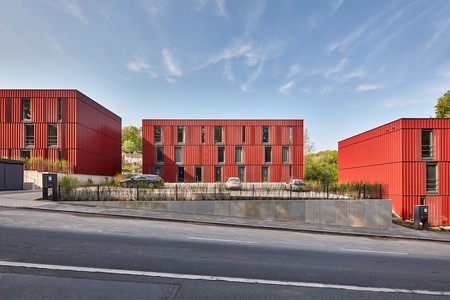Ecodistrict Bords de Seine
Last modified by the author on 11/06/2018 - 10:35
Urban renewal
- Address 1 - street : 92130 ISSY-LES-MOULINEAUX, France
- Population : 1 500 hab
- Number of jobs : 1 200 emplois
- Starting year of the project : 2008
- Delivery year of the project : 2015
Certifications :
-
3.4 ha -
7 000 000 €
The Ecodistrict Bords de Seine is part of Issy-les-Moulineaux's development policy, which has for many years enabled the renewal of numerous industrial sites and contributed actively to the construction of new homes and offices.
This district, delivered in 2015, was born on the site the former incineration plant of household garbage. The project reflects the search for a quality living environment where the river and vegetation contribute to the composition of the city.
With offices, housing, shops and public facilities (crèche, bi-lingual school), the district is an example of a functional and social mix.
Programme
- Housing
- Offices
- Businesses and services
- Public facilities and infrastructure
- Public spaces
- Green spaces
Project progress
- Operational phase
Key points
- Governance
- Quality of life
- Mobility
- Biodiversity
- Energy /Climate
Approaches used
- Ecodistrict national label
- Agenda 21
- Local charter
- Others
Certifications
- Ecodistrict national label
- Autre
More info
http://www.issy.com/en/homeData reliability
3rd part certified
Type of territory
Issy-les-Moulineaux is a town in the south of the Hauts-de-Seine, covering an area of 425 hectares, which has officially since 1 January 2018 69 941 inhabitants; the population of the City has increased by 31.6% since 1999. Issy-les-Moulineaux is part of Grand Paris Seine Ouest, which became on January 1, 2016 one of the twelve territories of Grand Paris Métropole (T3 ).
The district is part of the transformation of the Bords de Seine, site largely industrialized in the past and marked by many wastelands. The gradual conversion has made it possible to transform these spaces into mixed neighborhoods (offices, housing, shops, equipment), with the exception of the Portes de Seine business district, which has more naturally turned to the tertiary sector because of the proximity heliport (prohibited housing constructions). The development of the ecodistrict Bords de Seine (2nd tranche of the ZAC Bords of Seine) is located in the heart of these developments, in line with the development of the first tranche of the ZAC and Tri Postal sector.
It took place on the former grounds of the TIRU plant (Industrial Treatment of Urban Waste), which ceased its activity in 2007 following the construction of a new household waste treatment plant (called isséane) farther north on the issean territory.
The site offered a remarkable potential, both open to the Seine, and in particular Ile Saint-Germain park, and at the same time located a few steps from the city center. It was thus a question of returning this neighborhood to the population, which had not previously had access to it, and to create a link between the city and the river.
Climate zone
[Cfb] Marine Mild Winter, warm summer, no dry season.
More info
http://www.issy.com/bords-de-seinehttps://www.construction21.org/france/data/sources/users/11069/labelannexe29photos.pdf
Green areas, roofs included
4 620 m²
Public spaces area
14 680 m²
Office floor area
24 000 m²
Commercial floor area
2 500 m²
Public facilities floor area
3 500 m²
Housing floor area
48 400 m²
Number of residential units
782
Number of social housing units
169
Green spaces /inhabitant
Public spaces/inhabitant
Project holder
Project management
- Land service for missions related to land acquisitions,
- Legal service for the development of regulatory files, drafting of acts and contracts,
- Financial service for the optimization of the financial and fiscal management of the operation,
- Communication service for the design and implementation of concerted action, communication, reception of inhabitants and animation,
- "Market Managers" division, which manages contracts with suppliers,
- VRD expert who monitors the work (from design to delivery).
- the specification of environemental requirements and sustainable development, declining the charter according to each type of function (housing, trade, parking, nursery, school group);
- Project and Actor Management Guide;
- Site charter with low nuisance.
- ensure the proper application of the site charter,
- to emit the questions and expectations of local residents,
- obtain the information necessary for a good understanding of the project and the project.
- provide a written answer to each request,
- react and implement the appropriate corrective measures.
- a brochure presenting the project (editorial, objectives of an eco-district, program, phasing: depollution / deconstruction / construction, actors, glossary), for residents (residents and employees), "homeless" (transport users) in common and especially T2 ...), partners and future users,
- an evolutionary exhibition, installed in the administrative premises, but also declined and adapted to the information of construction site on palisade,
- articles in the municipal newspaper "Point d'Appui",
- a "sentinel" newsletter, for punctual information on the site's news and their specificities ...,
- a leaflet presenting the Green Building Charter for sentinels, residents, "homeless people", partners and future users,
- flyers, for residents and users, for punctual information on the functioning of the works (start-up, temporary disturbances ...).
Project stakeholders
SEM 92
Developer
TRIBU
Assistance to the contracting authority
groupe synthèse
Architecture agency
paysage urbain
Other
egis amenagement
Other
SOLUTIONS
- Urban project governance
- Citizen participation
Quality of life / density
The big goals for the neighborhood were:
-
Extend the city towards the river by regenerating the urban fabric and a new development of these spaces strongly marked by half a century of activity related to the treatment of waste, while leaving visual breakthroughs between the building, in order to open the city on the Seine;
-
Create a mixed district with various functions (office, housing, local shops);
-
reconnecting and remeshing this site, which has remained outside the neighboring structuring structures, particularly with regard to transport infrastructure (tramway, etc.);
-
create a qualitative layout that enhances the assets of the site and is consistent with RD 7 redevelopment projects.
- to have the ambition of an eco-district
The sustainable development guidelines for the neighborhood were recorded in the Development and Development Plan of the Local Urban Plan in effect at the time:
- preserve the great landscape and in particular improve the perception of the Seine;
- ensure the quality of public spaces, including improving the presence of plants and water in the city;
- increase the area of green spaces on the City and promote biodiversity
- promote alternative modes of travel to the automobile;
- promote urban redevelopment, including reclaiming strategic sectors;
- maintain demographic and economic dynamism while ensuring the satisfaction of new needs in terms of public services, ensure the diversity of housing supply and sustain employment while maintaining a balance between housing and activity;
- reconquer the banks of the Seine: remove the last locks between the city and the river,
- continue to open up a new network of public spaces, make riverbanks a place to walk.
Net density
Culture and heritage
The former garbage incineration plant was rebuilt three times on the same site since its creation in the early nineteenth century. In June 2010, the last chimney of the former garbage incineration plant, better known by the acronym "TIRU" after the name of the operating company, was struck down. Its destruction symbolizes the end of the industrial era, which marked the city for a century, and the birth of the eco-district.
On the occasion of this event, two artists of the "Arches d'Issy" association of professional artists, presented the drafts of works of art that were made from pieces of concrete from the fireplace and then installed in the district.
In addition, from June 7 to July 10, 2011, the "Zoom 92130" photographers' association exhibited at the media center downtown the shooting of the factory carried out in 2006 ("Time of the TIRU").
Social diversity
In its Development and Sustainable Development Project, the City sets itself the objectives of increasing the supply of housing and maintaining a geographically distributed social mix.
Almost 24% of the City's main housing units are social housing and the eco-neighborhood is part of this effort. It includes 12,500 m² of social housing and responds to the diversity of socio-economic profiles of the population by the type and surface of housing offered.
The goal of social and generational diversity is reflected in a diversified supply of housing, both in the typology (from T1 to T6) and in the status (30% in social rental, 70% in home ownership).
The breakdown is as follows: For home ownership housing: 15.6% T1; 30.7% of T2; 30.2% of T3; 20.4% of T4; 3% of T5; 0.2% of T6
For social rental housing: 32.5% of T2; 38.5% of T3; 27.2% of T4; 1.8% of T5
Social inclusion and safety
The presence of many local shops (2500 m²) helps to create social links. The Intermarché brand is particularly involved in this neighborhood, with the desire to create a space where the Isseans can meet, have a drink, discuss and enjoy the green areas of the neighborhood. The supermarket managers have chosen to open a Colombus Café area within the Intermarché which has a terrace. This is a first for this brand.
Public spaces also have an essential structuring function, they ensure the opening of the neighborhood to the Seine and to the city center. Their design seeks to satisfy functional but also symbolic needs.
- Note: 50% of outdoor spaces to pedestrians and soft traffic.
The Madaule Place, located at the junction of the ZAC Garibaldi and the ecodistrict des Bords de Seine, has several dimensions: it punctuates the perspective towards the Seine and offer a social space. It reflects the desire to eventually build a homogeneous portion of the city.
The pedestrian mall, bordered by shops on the ground floor of buildings, creates a new centrality.
The "living together" is also reinforced by the cohesion of the territory since a reflection was conducted on the treatment of urban seams and public spaces. The creation of links with other areas of the city and its opening on the river and the island Saint-Germain are major objectives of the project.
Public spaces are a vector of social and generational diversity, with the development of playgrounds and gardens, paths that cross the various users and opening on poles of attraction (public facilities, shops and services, tram station).
The development of these outdoor spaces takes into account the accessibility of people with reduced mobility through appropriate arrangements, including the choice of color coatings, to promote the perception of space functions and the free movement of all.
Ambient air quality and health
The site of the district is that of the former garbage incineration plant, classified installation subject to authorization which ceased its activity in December 2007. The land belonged to the City of Paris which yielded it free and clean-up to SEM92.
The City of Paris has made a commitment to deconstruct the plant and clean up the land with regard to the future use of the site. In order to fulfill its obligations, it has called on specialist pollution control consulting firms that have carried out numerous studies and reports. The Prefecture has pronounced on these elements by confirming that the future use of the site was quite possible.
A Flood Risk Prevention Plan for the Seine in the Hauts-de-Seine department was approved by prefectural order of 9 January 2004 and annexed to the PLU. The project, located in Zone B, takes into account the requirements and recommendations of the PPRI in its planning and construction principles.
The noise levels of the traffic lanes were taken into account for the construction of the buildings. Only the Stalingrad Battle Wharf, skirting the west facades of Block B, is the subject of an acoustic classification for the land transport infrastructure (category 3). Thus, the value of the minimum insulation of buildings is 38 dB for façades directly on the wharf, 35 dB and 32 dB for other facades depending on their distance and exposure.
Other channels have lower acoustic constraints:
- the Mall, open to car traffic to the north and pedestrian to the south;
- the Rue du Passeur de Boulogne, open to traffic;
- the street of Galiote, pedestrian but skirted by the tramway
On block C, the residential building leans against the street of the Passeur de Boulogne to open widely on the south, distant to maximum of the noise nuisances possibly caused by the circulation of the tramway. In addition, the double-glazed windows ensure a satisfactory acoustic attenuation. Particular attention was paid to the acoustic insulation between housing and shops on the ground floor.
For island D, the acoustic measurements made it possible to determine the insulation level with respect to the tramway: 35 dB for directly exposed façades (building B, C and D) and 33 dB for the side façades of building E.
Hygrothermal comfort is ensured by an optimized device. The design choice results from an overall analysis of the advantages / disadvantages with regard to the following criteria: architecture, air quality, maintenance and upkeep, energy consumption, investment cost, acoustic comfort, types of materials.
Finally, for interior cladding, in accordance with the requirements of the Isséo charter, the choice was focused on products with the best environmental and sanitary characteristics.
SOLUTIONS
- Urban densification
- Proximity services
- Air quality
Local development
With a proactive policy, the City has created a successful economic framework for its territory, which is reflected in the presence of over 1,400 businesses, 800 traders and artisans, and many jobs. Issy-les-Moulineaux has become a pole of reference, which is part of the project of SDRIF in a "territory driving regional economic development to boost" and a "business district of international influence to consolidate."
The Bords de Seine eccodistrict is contributing to this economic dynamism with the head office of BNP Paribas Immobilier (24,000 m² of offices, ie 1,000 to 1,200 employees) as well as shops and local services (2,500 m²). Businesses and related jobs also contribute to this dynamic. Note: As part of the opening of Intermarché in this new district, recruitment procedures have been put in place by Seine Ouest Enterprises and Employment (local structure acting for jobseekers) to make use of strong forces of the territory.
A mission of diagnosis and programming in commercial matters was entrusted in May 2008 to the company Cushman & Wakefield. The study highlighted the proximity of many trade poles whose radiation is regional or local. In addition, a small commercial polarity developed around Place Madaule.
Given the dense competitive environment and the planning party limiting the use of the car within the future district, the proposed offer provides a close commercial network. An analysis of the businesses already established on the site has allowed the research department to define a "merchandising" plan to complement and diversify the site's offer of shops and services, without destabilizing those around. Established: a pharmacy, a brewery, a hairdresser, a florist, a bank, an optician. In addition, Intermarché has also established itself in this ecodistrict has implementend very innovative initiatives.
These commercial areas are arranged along the course of the Old Bakery, forming a continuous linear throughout the facade of the building and on the corners in return from the street of the Passeur de Boulogne to the street of Galiote. This continuity gives a great readability to the activity and a great flexibility in its configuration and its evolution.
Functional diversity
The reconversion of this industrial wasteland was designed to ensure a functional mix on the scale of this new neighborhood and to integrate it into the surrounding neighborhoods (the Carthusians, the Tri Postal, the Pont d'Issy and the 1st district of the ZAC of the Banks of the Seine).
The overall program of the Bords-de-Seine eco-district is composed of:
- 48,400 m² of housing, or 169 social and 175 hotel residences;
- 24,000 m² of offices (head office of BNP PARIBAS Immobilier, ie 1,000 to 1,200 employees);
- 2,500 m² of shops and services (supermarket, bakery, pharmacy, brewery, medical office, concierge for individuals and businesses);
- a school group of 8 classes;
- an early childhood structure of 60 cradles.
The general principle of urban composition that has been retained is that of an island open to public space, with which it maintains a permanent dialogue.
Functional diversity has also been thought out at the scale of the building since shops, services and public facilities are integrated into the ground floor of residential buildings, or even upstairs for equipment. This interweaving was studied beforehand by the architect-urban planner of the ZAC and the public facilities programmer and then imposed on the promoters as part of the consultation.
A reflection on the quality of use and the sharing of public spaces, a vector of social and generational diversity, is reflected in the development of places of relaxation and leisure adapted to all as previously mentioned.
The establishment of shops along the course of the Old Bakery and facing the tram station allows to accompany the pedestrian promenade from the Garibaldi district to the banks of the Seine.
The proximity of public transport (tram T2, RER C, bus) and the mix of functions favor the limitation of the needs of motorized trips. In fact, the neighborhood is home to local shops, public facilities, a nursery and a school group to meet the needs of families. Neighboring operations (1st tranche of ZAC Bords de Seine, ZAC Garibaldi) also have a number of shops and equipment.
% of public spaces
% of office area
% of commercial area
Circular economy
Thus, at the scale of the building, the specification of environemental requirements and sustainable development recommends :
SOLUTIONS
- Business development
Mobility strategy
The public transport service is provided by the T2 tramway (Jacques-Henri Lartigue station, the RER C (Issy-Val-de-Seine station), several bus lines located at the "Jacques- Henri Lartigue "of the T2 tram, the project aims to limit the role of the automobile and promote alternative travel by adapting parking standards in the Local Plan of Urbanism, the development of a network of soft traffic dedicated or "zone 30", the creation of a shared parking and the use of Vélib with a station located at the right of the tram station "Jacques-Henri Lartigue" .The objective of the charter is to bring back less than 20% of the private car for early childhood and school journeys, 50% for commuting, 70% for weekly shopping. Concerning the T2 tramway, the "Jacques-Henri Lartigue" station was previously only accessible from Madaule Square in the Garibaldi district. With the development of the eco-district and the reconstruction of a road network, users can now reach it by other pedestrian routes. In addition, a new access to the platforms of the station was created, in the continuity of the street Eugène Atget formerly deadlocked. The T2 connects the "Porte de Versailles" to "La Défense" in less than 30 minutes, with a frequency of 4 minutes in rush hour. The T2 is interconnected with the RER C, lines 8 and 12 of the metro and the tramway T3.
It should be noted that 50% of public spaces are dedicated to pedestrians. The soft link network is compatible with the functions of ecological corridors.
The design of the project limits the importance of the automobile and encourages alternative travel. Thus, a network of soft traffic irrigates the neighborhood, in connection with the existing urban fabric and the banks of the Seine. In the south, the space is dedicated to pedestrians and cycles while in the north, the site is served in "zone 30". In terms of regulations, parking standards have been adapted in the Local Urban Plan. When it was approved in 2005, the PLU provided for a minimum of 1 place for dwellings of less than 3 rooms and a minimum of 1.5 places above, as well as an area of 0.5 m² per dwelling for the development of bike rooms accessible on one level and secured. On the occasion of the modification of the PLU in 2008, the car parking standard was reduced to 1 place for all types of housing and the area dedicated to bicycles was increased to 1.5 m² per dwelling unit.
In order to reduce the use of the car and optimize parking, a shared car park of 158 places was created under the course of the Old Bakery, to meet different needs:
- visitors to Île Saint-Germain,
- public equipment professionals (school group, nursery),
- visitors to offices and housing,
- customers of the shops (restaurant, supermarket ...) ...
This public car park hosts a car-sharing station composed of electric vehicles. At the same time, surface car parking was limited and mainly targeted at people with reduced mobility, public facilities (drop-off), and businesses (limited time). The nursery and the school group are located in this pacified zone where only emergency vehicles can be accessed permanently and delivery vehicles are regulated. Gentle connections to the river and Île Saint-Germain have also been strengthened with the project "Rive Gauche Valley" of the General Council of Hauts-de-Seine, including a "plateau" where traffic is slowed down and crossings secured . Two types of cycle routes are proposed:
- for "intensive" use, bidirectional, continuous, secure tracks in relation to the RD7 causeway and the pedestrian promenade.
- for a "leisure" use, the paths along the Seine.
The specification of environemental requirements and sustainable development sets out the implementation of provisions allowing a "sustainable" realization of weekly shopping by favoring the tram and by organizing deliveries at home or a delivery relay on the ZAC, in addition to local shops . Finally, with regard to garbage collection, a pneumatic collection system was set up with direct transport to the waste treatment plant, which made it possible to eliminate the transport of waste.
SOLUTIONS
- Soft transportation
- Electric vehicles
- Parking management
Smart City strategy
The City of Issy-les-Moulineaux has been thinking about new technologies and digital technology since the 1980s. In 2011, the City created "Issy Grid", in partnership with Bouygues Immobilier, and actors bringing together all strategic and technical skills of the smart grid. The goal of this full-scale laboratory is to achieve savings and reduce the carbon footprint by optimizing consumption and pooling resources between offices, homes and businesses. Naturally a deployment of innovative services was sought on the eco-district of the Bords de Seine. On Block B, the GISELE platform was set up in the dwellings to allow co-owners and tenants to manage their housing, including advice on starting up and maintaining housing equipment, and monitoring tools. consumption of energy and water, etc. In the same vein, the new Intermarché has set up numerous digital features and innovations with, for example, self-service checkouts, a self-scanning of its shop via its Android phone and NFC technology: by approaching its phone to the label price of a product, the customer records it on his future shop ticket. This concept was also awarded soon after in the United States, at the NRF Show, a technological showcase where the most advanced companies come to present their know-how for sale.
SOLUTIONS
- Digital services
Water management
The actions implemented in terms of water consumption allow a reduction of at least 20% compared to a reference consumption. The effort to reduce drinking water consumption concerns:
- the design of the network with shut-off valves allowing a possible intervention on the network without wasting water;
- the limitation of the network pressure;
- ease of maintenance of pipes and equipment to limit leaks;
- the use of efficient appliances (flush toilets with variable volume equipped with a control to select a suitable volume of water, flow reducers to reduce the consumption of faucets and showers).
The nature of the soil does not allow the infiltration of rainwater, the management of these in public spaces can be achieved only by storage devices or infiltration after purification. The ground plan and the general slope of the lands offered the opportunity to set up rainwater harvesting. Several devices are set up according to the spaces: gutters, valleys, depressions, wet ditches. Thus soil and planted ground cover absorbs runoff water, the excess of which is drained to cascaded valleys and then to a filtering pond (phyto-restoration by macrophyte plants) and flow control.
Rue Eugene Atget is a depression, with gently sloping banks, in the central planted bench that collects rainwater. Rue de la Galiote is a valley. Rue du Passeur de Boulogne, the water is recovered in an enlarged valley with softened edges. Course of the Old Bakery, a valley retrieves rainwater and channels it in a shallow ditch, leading to a space in disbursement that can store water during heavy rainfall.
This widened space is 50 cm deep for the main basin and 25 cm deep for the submergible grassland area. This device thus makes it possible to regulate the flow rejected to the sewerage network. Helophyte plantations, adapted to the conditions of variable hygrometry (rushes, iris, baldingeres, loosestrife, mint) are chosen for their filtering power and their landscape character. Persistent low shrubs are planted along these ditches as protection. The bottom of the valleys and part of the basin-reservoir are in sealed pebbles.
The watering of outdoor green spaces and the cleaning of common premises can be ensured through the recovery of rainwater on the roof.
Soil management
The City and Sem92 wished to associate the competence of an ecologist with the urban project management for the design of the public spaces. On the basis of faunistic and floristic inventories already carried out, notably by the General Council, and on-site visits, ECOSPHERE has worked in collaboration with the landscape architect regarding the diversity of the environments to be created.
In addition to the ecological function of the green spaces of the site, the greening of the ZAC provides many other environmental functions at the neighborhood level: rainwater management, hygrothermal regulation, braking of air flows and improvement of the quality of the water. air. This choice also imposes modes of realization and management of the created natural environments: planting of local and indigenous plant species, differentiated management, ecological, recreated environments ...
Waste management
The objective was to increase the amount of waste recovered to 28% of the total waste produced / person / year, the national average being equal to 19%. From the development plan, it was necessary to provide collection circuits as well as modes of transport to the sites of valorization. In terms of waste collection, the SEM commissioned a design office: INDDIGO (in a consortium with SAGE) to carry out a study concerning the opportunity to implement a collection of waste by tire. Indeed, the location of the eco-district in relation to the Isséane plant makes it a site particularly compatible with this collection system: the implantation of the terminal inside the plant itself makes it possible to eliminate the transport of waste.
This waste collection system has the following advantages:
- permanent and easy access to the collection points, located on the ground floor of each stairwell,
- an improvement of the selective collection,
- a considerable reduction in visual, olfactory and noise pollution
- optimization of hygiene and safety for residents and collection staff;
- the elimination of the risk of fire;
- the removal of containers in buildings and on public space;
- the elimination of pre-collection charges (maintenance of premises and bins, exit charges and return of bins ...);
- the decrease in the number of collection trucks;
- sorting waste at source to facilitate recycling;
- automatic control over the entire network and network maintenance by manholes.
The collection method is adapted to the sorting of waste, with terminals dedicated to residual household waste and household packaging. The glass can not however be collected by suction for reasons of abrasivity of the pipes. The principle of voluntary contribution is therefore preserved and glass silos are installed.
For the convenience of users, the collection terminals are arranged on their usual routes in the lobby or at the foot of buildings, and therefore accessible to all. Signage makes it possible to sensitize the inhabitants to the sorting of the waste.
For Intermarché, and to move towards more recycling, all the plastics and cartons of the store are collected via delivery trucks and then recovered from the company's paper and plastic regenerators.
It should also be noted that during the construction period, a low nuisance building charter was developed and was attached to the companies' consultation file as a contractual document. It covered among others:
- the limitation of the nuisances, noise, pollution and risks induced by the construction site, in occupied site;
- the maximum recovery of site waste, according to local sectors: at least 50% of inert waste and 15% of other waste;
- control of energy and water consumption.
The various promoters were therefore asked to reduce waste at the source. Different solutions have been implemented:
- choice of constructive systems, especially the pre-wall,
- adapted layout to reduce falls,
- limitation of packaging,
- centralization of concrete production on the site,
- factory prefabrication of steels.
Concrete rubble has been reduced by good site preparation, reservation plans and effective co-ordination between stakeholders who avoid jackhammer replacements.
Polystyrene waste has been avoided by the realization of booking boxes in other materials (wood for example). A thorough sorting was put in place on the site, including:
- metals (to be recycled),
- cardboard packaging, mainly produced by technical batches (packaging that has not contained or contains hazardous products must be recovered: recycling or incineration with energy recovery),
- wood (to recycle or to recover energy),
- thermo-acoustic plaster + polystyrene or plaster + glass wool (to be recycled) doubling complexes.
SOLUTIONS
- Water management
- Soil management
- Waste management
- Citizen-awareness
Biodiversity and natural areas
The site is on the transit of plant and animal species (on an East / West and South-East / North-West axis). The planting choices of the site (public space, private parcel and building) facilitate the transit, and even the sedentarisation, of the local flora and fauna.
- by a network of relay spaces planted, at the scale of the ZAC, to ensure the passage of insects and birds (150 - 200 m).
- by choice of species and plant and shrub structure adapted to the life of the species (the bird nest at a certain height in a rather calm environment, the flying insects prefer fruit or honey species, the crawling insects move in quiet, dark and humid environments ...).
The project reflects the search for a quality living environment where the river and vegetation contribute to the composition of the city.
Given the situation of the operation, along the Seine and in front of Île Saint-Germain, it was a question of creating public spaces favorable to biodiversity. Two places are to be considered more particularly as true ecological continuities:
- the course of the Old Bakery, which connects the embankments of the tramway to the banks and enjoys a wide grip; it is presented as a central, hilly green carpet. Mounds of 1.20 m provide a sufficient height of land for plantations of medium development. Densely raised, it brings freshness in summer. The plantations are staggered in height: ground covers, shrubs, shrubs, stems, hardwoods with conifers.
- Rue de la Galiote, in the continuity of the embankments of the tramway.
In general, public spaces include the following requirements:
- Preservation and continuity of living ecosystems by planting at several heights and installing on vertical supports of climbing plants. The project has at least 3 plant strata: ground covers (for insects), shrubs (for bird food) and medium stems and stems (for nesting);
- Choice of carpet species to facilitate maintenance (differentiated management) and offer a wide variety of aspects (perennials);
- Choice of native species, no invasive species, some horticultural plants for color and variety of landscapes;
- Choice of tree shafts with dense and compact crowns to minimize nuisance (wind and noise);
- Predilection for species of different growths and diverse species, adapted to the climate and the site, to the dimensions of the street;
- Role of aquatic vegetation, present around the pond, for the purification of water by settling, filtering and oxygenation for watering.
More precise work was continued in the project phase (PRO) in collaboration with the ECOSPHERE research department. In total, green spaces represent 4,620 m² of 14,680 m² of public space, or more than 30%.
In addition, the integration of biodiversity has resulted in landscaping prescriptions for promoters concerning the development of core islets.
SOLUTIONS
- Management of natural areas
- Environmental charter
Climate adaptation, resources conservation, GHG emissions
The bioclimatic principles have been at the heart of the planning parties of the Bords de Seine eco-district. More generally, the choices of architectural design meet the requirements of use but also environmental performance, which have also been the subject of prescriptions in the terms of reference for consulting teams and in project monitoring workshops. The ground plan includes a sunshine requirement at least 2 hours a day, even in winter. The inhabitants were made aware of the design of the buildings through the green gestures booklets that were issued to them.
For example, within Block D, North-South-oriented faults allow light to penetrate the island core, even during the worst periods. They are treated in clear and slightly reflective materials to illuminate opposite facades and optimize the diffusion of light. They also promote efficient natural ventilation, thus contributing to summer comfort. The interior garden has been designed as a micro-landscape evoking an undergrowth.
The control of the energy needs of the neighborhood has been made possible by optimizing the choices of urban morphologies, the valorization of the climatic assets (sun, wind, light ...).
The buildings are low energy consumption (BBC) and certified NF Housing Démarche HQE to reduce both tenant charges and CO2 emissions. The Bords de Seine eco-district combines bio-climatic design, reinforced insulation, high efficiency equipment, renewable energy and rainwater recovery.
The target level of performance for buildings is at the level of the energy issues at the end of the delivery of the buildings. It corresponds roughly to a gain of 50% compared to the thermal regulations in force at the time of the filing of building permits. A large part of the residual needs to be covered is through decentralized (solar hot water) or centralized renewable energies. Public facilities and development works meet requirements of equivalent level.
Energy sobriety
Monitoring devices for water and electricity consumption have been set up in all housing units. For example, the "GISELE" device was set up in Block B.
The inhabitants have also received booklets sensitizing them to eco-gestures, whether it concerns electricity, water, indoor air quality or even waste.
Regarding Intermarché, and in order to reduce the ecological footprint, the entire store has been equipped with LED lighting and 90% of cold furniture has doors to limit energy consumption.
Energy mix
The city and SEM92 have imposed that the need for hot water is covered at least 40% by renewable energy sources, here provided by solar thermal panels. It also required that all buildings in the program be connected to the Parisienne Compagnie de Chauffage Urbain network, which ultimately aims to provide 50% renewable energy.
A specialized consultancy firm (EXPLICIT) has been commissioned for the elaboration of energy scenarios and recommendations concerning the energy choices to be made in the ZAC Bords de Seine.
The additional domestic hot water is produced by the solar thermal panels installed on the roof, in the following proportions:
- 40 and 60% on block B (220 m² for tourist residence and 80 m² for housing);
- about 50% on Block C (243 m²);
- a minimum of 30% on Block D.
SOLUTIONS
- Climate adaptation
- Renewable energies
- Low-carbon materials/ infrastructure
Buildings
For the equipment, the objectives were as follows:
- the nursery: level corresponding to the BBC label, ie a primary energy consumption
- the school group: level corresponding to Passivhaus,
- Offices achieve the goal of Very High Energy Performance BNP PI is part of a certification process "NF Tertiary Buildings - HQE ® Approach".
- for housing, as an example on Block D:
- BBC label obtained associated with the H & E: Cep certification on 7 buildings between 51.41 kWh / m² and 57.53 kWh / m²
- High-performance envelope: U pack <U pack ref between 0.53 and 0.68
- Efficient Energy System: CPCU heating with a percentage of renewable energy. ECS: Heliopac ® system + extra CPCU
Reasons for participating in the competition(s)
The new EcoQuartier reintroduces biodiversity, both in terms of fauna and flora. Green spaces highlight local species and those requiring little watering and maintenance.Soil waterproofing is limited and basins participating in the landscape allow the retention and infiltration of rainwater.
The landscaping project compensates for the density of the district, which has enabled the construction of 782 dwellings (including 169 social and 175 hotel residences), 24,000 m² of offices and 2,500 m² of shops.
The course of the Old Bakery, which connects the embankments of the tramway to the banks has a wide hold (36 meters wide). It is presented as a central green carpet, hilly contributing to the green mesh of the Banks of the Seine.
The result is a neighborhood where life is good and that allowed the Isseans to reconnect with the park of Ile Saint-Germain and the Seine.
Building candidate in the category

Grand Prix Ville Durable











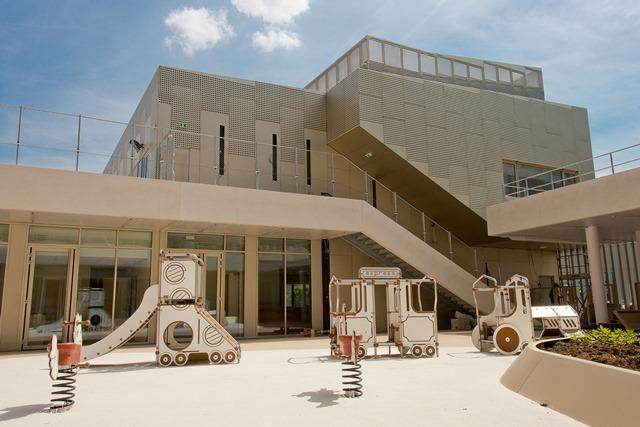
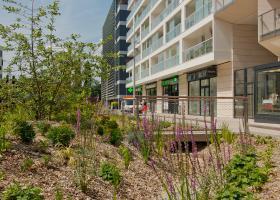


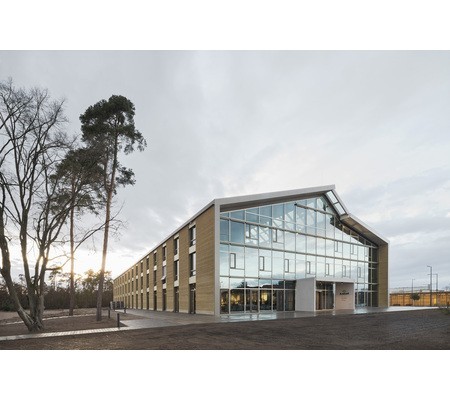
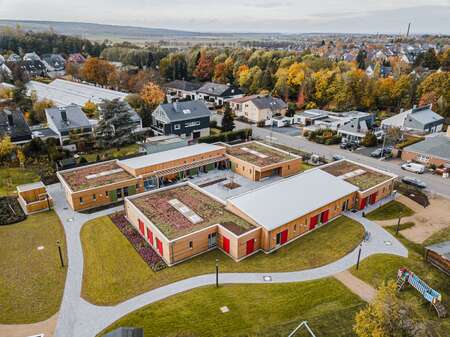
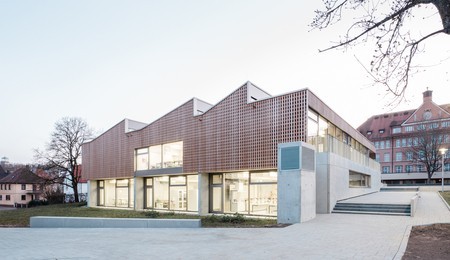
![Lister Dreieck [EN]](https://www.construction21.org/deutschland/data/sources/users/1282/.thumbs/20210325144314-rh2716-0082.jpg)
![AUDI Brand Experience Center [EN]](https://www.construction21.org/deutschland/data/sources/users/1281/.thumbs/20210324141015-atc-iv-aussen-ost-v1-2-0201.jpg)
